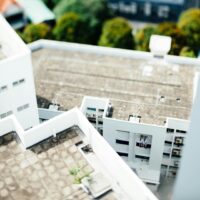The ongoing Israel-Hamas conflict has not only devastated civilian infrastructure but also struck at the heart of Gaza’s religious heritage. In a rare show of solidarity, Christian leaders from around the world have visited Gaza’s bombed churches, including the historic Saint Porphyrius Church and the Church of the Holy Family, both of which were severely damaged by Israeli military strikes in recent months. These visits come as the war enters its third year, with over 68,500 Palestinians killed and entire neighborhoods reduced to rubble. The destruction of religious sites has sparked global outrage, with Christian leaders calling for the protection of holy places and an immediate ceasefire.
This report examines the impact of the conflict on Gaza’s Christian community, the role of religious leaders in advocating for peace, and the broader implications for interfaith relations in the Holy Land. It also explores the challenges faced by Palestinian Christians in the West Bank, where settler violence and economic hardship are driving families to leave their ancestral homes.
The Bombing of Gaza’s Churches: A Symbol of the War’s Human Cost
On July 2025, an Israeli shell struck the Church of the Holy Family in Gaza City, one of the few remaining Christian places of worship in the enclave. The attack, which occurred during a period of intense fighting, damaged the church’s structure and displaced dozens of families who had sought refuge there. The strike was not an isolated incident: earlier in the conflict, the Saint Porphyrius Church, one of the oldest in Gaza, was also hit, killing at least 18 civilians sheltering inside.
The bombings have drawn condemnation from global religious figures, including Cardinal Pierbattista Pizzaballa, the Latin Patriarch of Jerusalem, who described the attacks as a “violation of the sanctity of life and faith.” Pizzaballa, who recently visited Gaza, emphasized that churches are not just buildings but symbols of hope for a community already on the brink of extinction. “People keep dying every day out there,” he said in an interview with the Associated Press. “But at least in the air, you feel something different, you hope that maybe this is going to finish.”
The Vatican, too, has repeatedly called for a ceasefire, with Pope Leo XIV condemning the “inhuman massacre” of civilians and urging both sides to end the “perverse chain of hatred.” However, the Vatican’s stance has evolved under the new pontiff, who has sought to balance empathy for Gaza’s suffering with recognition of Israel’s security concerns.
The Plight of Gaza’s Christian Community
Gaza’s Christian population, which once numbered in the thousands, has dwindled to just a few hundred families. Most are Greek Orthodox, with a small Catholic minority. The war has exacerbated their vulnerabilities, forcing many to flee or seek shelter in already overcrowded churches. Those who remain face daily struggles: food shortages, lack of medical care, and the constant threat of airstrikes.
Father George Hernandez, a priest at the Church of the Holy Family, recounted the horror of the July strike: “We were in the middle of Mass when the explosion shook the walls. The children were screaming, and the elderly couldn’t move fast enough. We had nowhere to go.” The church, which had been a sanctuary for displaced families, now stands as a grim reminder of the war’s indiscriminate destruction.
The psychological toll is equally devastating. Many Christians in Gaza report feeling abandoned by the international community. “We are a forgotten minority,” said Mira Samara, a Gaza City resident whose home was destroyed in an airstrike. “The world talks about Muslims and Jews, but who speaks for us?”
Christian Leaders’ Visits: A Beacon of Solidarity
In October 2025, a delegation of Christian leaders, including Cardinal Pizzaballa, Archbishop Hosam Naoum of the Episcopal Church in Jerusalem, and representatives from the World Council of Churches, made a rare visit to Gaza. Their trip, coordinated with the United Nations, aimed to assess the damage to religious sites and deliver humanitarian aid to the Christian community.
The delegation’s visit was not without risk. Gaza’s roads are littered with debris, and movement is restricted by Israeli military checkpoints. Yet, the leaders insisted on seeing the destruction firsthand. “We had to come,” said Archbishop Naoum. “Silence in the face of such suffering is complicity.”
During their visit, the leaders met with local clergy and families affected by the bombings. They also held an ecumenical prayer service at the damaged Saint Porphyrius Church, where they lit candles for the victims and called for an end to the violence. “This church has stood for centuries as a testament to faith,” said Cardinal Pizzaballa. “Its destruction is a wound not just for Christians, but for all humanity.”
A Call for Protection of Holy Sites
The bombing of churches in Gaza has reignited debates about the protection of religious sites during armed conflicts. International law, including the 1954 Hague Convention for the Protection of Cultural Property, prohibits the targeting of cultural and religious heritage. However, enforcement remains weak, and violations often go unpunished.
Christian leaders have urged the International Criminal Court (ICC) to investigate the bombings as potential war crimes. “The deliberate or reckless destruction of places of worship is a violation of the most basic human rights,” said Dr. Sarah Leah Whitson, executive director of Democracy for the Arab World Now (DAWN). “Accountability is essential to prevent future atrocities.”
The Israeli military has defended its actions, stating that Hamas operatives often use civilian infrastructure, including churches and mosques, to store weapons and launch attacks. “We take every precaution to avoid civilian casualties,” said an Israeli Defense Forces (IDF) spokesperson. “But Hamas’s tactics make it impossible to guarantee complete safety.”
The West Bank: A Parallel Crisis for Palestinian Christians
While Gaza’s Christian community faces the immediate horrors of war, their counterparts in the West Bank are grappling with a different but equally existential threat: settler violence and economic strangulation. In villages like Taybeh, the last entirely Christian town in the West Bank, families live under constant fear of attacks by Jewish settlers, who have escalated their campaigns of intimidation and land seizures.
Reverend Bashar Fawadleh, parish priest of Christ the Redeemer Catholic Church in Taybeh, described the situation as a “slow-motion ethnic cleansing.” “We are so tired of this life,” he said. “The settlers burn our olive trees, block our roads, and attack our children. The Israeli army does nothing to stop them.”
The economic toll is equally severe. Many Christian families in the West Bank rely on tourism, but the war has devastated the industry. In Bethlehem, once a bustling pilgrimage site, hotels and shops stand empty. “We used to welcome thousands of visitors during Christmas,” said Samir Canawati, a Bethlehem shopkeeper. “Now, we’re lucky if we see a dozen.”
Settler Violence and the Erosion of Hope
Since October 2023, settler violence in the West Bank has surged by over 50%, according to the United Nations Office for the Coordination of Humanitarian Affairs (OCHA). Incidents include:
- Arson attacks on churches and homes: In September 2025, settlers torched the Hajja Hamida Mosque in Deir Istiya, scrawling hateful graffiti on its walls. While the Israeli military condemned the attack, no arrests were made.
- Land confiscations: Settlers have seized hundreds of acres of Palestinian farmland, often with the tacit approval of Israeli authorities. In Taybeh, farmers report being barred from harvesting their olive groves, a primary source of income.
- Restrictions on movement: Israeli checkpoints and “flying roadblocks” have made travel between West Bank towns nearly impossible. Schools and hospitals are frequently cut off, leaving residents without access to essential services.
- Attacks on clergy: Priests and nuns have been spat on, verbally abused, and physically assaulted by extremist settlers. In Jerusalem’s Old City, Christian clergy report a rise in harassment during religious processions.
The Israeli government has dismissed these incidents as the work of a “few extremists,” but Palestinian Christians see a pattern of systemic discrimination. “This is not about a few bad apples,” said Father David Khoury of St. George Greek Orthodox Church. “It’s about a policy that treats us as second-class citizens in our own land.”
The Role of the International Community
The plight of Palestinian Christians has drawn increasing attention from the international community. In October 2025, the U.S. State Department issued a statement condemning settler violence and calling for the protection of religious minorities in the West Bank. “The United States stands with all faith communities in the Holy Land,” said Secretary of State Marco Rubio. “Attacks on places of worship are attacks on the values we all share.”
The European Union has also expressed concern, with the EU’s foreign policy chief, Josep Borrell, warning that the “erasure of Christian presence in the Holy Land would be a tragedy for humanity.” However, critics argue that these statements have done little to change the situation on the ground.
Human rights organizations, including Amnesty International and Human Rights Watch, have documented numerous cases of settler violence and called for sanctions against Israeli officials complicit in the abuses. “The international community must move beyond words,” said Omar Shakir, Israel and Palestine Director at Human Rights Watch. “Targeted sanctions and arms embargoes are necessary to hold those responsible to account.”
Churches as Targets: A Historical Pattern
The targeting of churches in Gaza is not an isolated incident but part of a broader pattern of attacks on religious sites in the Israel-Palestine conflict. Since 2000, over 50 churches, mosques, and holy sites have been damaged or destroyed in the region, according to the Holy Land Christian Ecumenical Foundation (HCEF). These include:
- The 2014 bombing of the Baptist Church in Gaza, which was hit by an Israeli airstrike during Operation Protective Edge.
- The 2021 arson attack on the Church of the Multiplication in Tabgha, Israel, by Jewish extremists.
- The 2023 vandalism of the Cemetery of the Latin Patriarchate in Jerusalem, where graves were desecrated.
These attacks have fueled fears among Palestinian Christians that their presence in the Holy Land is under existential threat. “We are the living stones of this land,” said Sami El-Yousef, CEO of the HCEF. “If we leave, the Holy Land will lose its soul.”
Faith Under Fire: The Psychological Toll on Gaza’s Christians
Beyond the physical destruction, the war has inflicted deep psychological wounds on Gaza’s Christian community. Many report symptoms of post-traumatic stress disorder (PTSD), including nightmares, anxiety, and depression. Children, in particular, are struggling to cope with the constant violence.
Dr. Rula Giadalla, a psychologist working with Gaza’s Christian families, described the situation as a “mental health crisis.” “These children have seen their homes destroyed, their friends killed, and their churches bombed,” she said. “They have no safe spaces left.”
The lack of access to mental health services exacerbates the problem. Gaza’s healthcare system, already overwhelmed by the war, has little capacity to address psychological trauma. International aid organizations, such as Médecins Sans Frontières (MSF), have stepped in to provide counseling, but the need far outstrips the available resources.
Stories of Resilience
Despite the hardships, Gaza’s Christians have shown remarkable resilience. Many have opened their homes to displaced families, regardless of faith. Nadia Awad, a Gaza City resident, turned her apartment into a makeshift shelter for Muslim neighbors after their home was destroyed. “We are all suffering together,” she said. “Faith teaches us to help one another.”
Others have found solace in their faith. Father Manuel Musallam, a priest at the Holy Family Church, has organized daily prayer sessions for traumatized families. “Prayer gives us strength,” he said. “It reminds us that we are not alone, even in our darkest hours.”
The Future of Christianity in the Holy Land
The war in Gaza and the escalating violence in the West Bank have raised urgent questions about the future of Christianity in the Holy Land. With families fleeing and churches under attack, many fear that the Christian presence—a continuous tradition since the time of Jesus—could disappear within a generation.
Cardinal Pizzaballa has warned that without immediate action, the Christian community in Gaza and the West Bank could collapse. “We are at a tipping point,” he said. “If the world does not act now, it may be too late.”
Efforts are underway to support the remaining Christians. The Latin Patriarchate of Jerusalem has launched a fundraising campaign to rebuild damaged churches and provide aid to displaced families. International Christian organizations, such as Open Doors and Aid to the Church in Need, are also mobilizing resources.
A Call for Unity
Christian leaders have emphasized the need for unity among all faith communities in the Holy Land. “This is not a conflict between Muslims and Christians or Jews and Arabs,” said Archbishop Naoum. “It is a struggle for justice and peace. We must stand together.”
Interfaith dialogues have been organized in Jerusalem, Bethlehem, and Nazareth, bringing together Christian, Muslim, and Jewish leaders to discuss shared concerns. While these efforts have yet to yield tangible political results, they offer a glimmer of hope in an otherwise bleak landscape.
Conclusion: A Test of Humanity
The bombing of Gaza’s churches and the suffering of its Christian community are stark reminders of the human cost of war. As the Israel-Hamas conflict grinds on, the international community faces a moral imperative: to protect the innocent, preserve the sanctity of religious sites, and work toward a just and lasting peace.
The visits by Christian leaders to Gaza’s bombed churches are more than symbolic gestures. They are a call to action—a demand that the world not turn a blind eye to the erosion of faith, culture, and humanity in the Holy Land. The survival of Gaza’s Christians, and indeed of all Palestinians and Israelis, depends on it.
In the words of Cardinal Pizzaballa, “We must rebuild not just buildings, but trust. We must heal not just wounds, but hearts. And we must ensure that the Holy Land remains a place where all people—Christian, Muslim, and Jew—can live in peace and dignity.”






